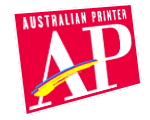White & Gillespie open new digital flexo facility
Packaging prepress specialists White & Gillespie reached another historic milestone when partners Geoff White and Mark Gillespie cut the ribbon to their new digital plateroom, officially launching the company’s move into direct-to-plate processing. Sharon Harrison reports. Responding to calls from the marketplace to provide digital flexographic plates, the company has installed a Creo Thermoflex Wide II platemaker and full BASF nyloflex FV processing line. The installation was the culmination of an 18-month investigation to find and install the right imaging and processing technologies to take them into the growing digital market.
The Thermoflex installation is also a milestone for Creo as it is the first Thermoflex Wide II installed in the Australia/New Zealand region. Mark Wilton, Creo marketing manager, honoured the occasion by presenting a plaque to White and Gillespie, marking the start of a new relationship between the two companies.
Relationships are an important part of White & Gillespie’s history. The company was founded in 1910 and, according to White, has continuing relationships with customers dating back to the 1930s. "Long-term relationship-building is a company goal," he says, pointing to the continuing relationship with long-time film supplier and BASF agency, Agfa, and the new association with Creo.
Attendees heard presentations from Andrew Adams, national sales & marketing manager at White & Gillespie, Noel Clacher, Agfa packaging product manager, and Andrew Swann, Creo sales representative. After the official opening, visitors were given the opportunity to see the two new systems in action.
At the front end of the system is the Creo Thermoflex Wide II large format device. Using multi-beam technology, the ThermoFlex images with a wide swath of lasers to achieve fast imaging speeds without spinning the imaging drum at very high RPMs. According to Wilton, slow drum-rotation has significant benefits like increased process control because it prevents vibration and balance problems, reducing instances of print artifacts, plate fly-off and inconsistent imaging.
Consistent imaging time between plates of different thicknesses means plate making productivity is not sacrificed on thicker flexographic plates. Masking unused areas of the drum is also unnecessary. This reduces plate load/unload time and media wastage and allows multiple plates to be imaged simultaneously. Plate handling is also improved with an air-assisted ‘vacuum and float’ feature - the ‘float’ allows easy plate movement across the drum and, when in position, the ‘vacuum’ holds the plate down firmly.
Finally, reduced dot gain on press provides greater image quality. The ability to hold a much smaller dot widens the tonal response range allowing smoother highlight blends, open shadows, sharper line work, and finer open reverses.
"The Thermoflex installation proves that the local market is progressing and the imaging technology is making inroads in the region," said Wilton. He also believes it points to the future success of flexo imaging for both Creo and the industry.
To ensure the quality of output through the whole process, White & Gillespie have taken what Agfa’s Noel Clacher describes as a ‘holistic approach’ to their digital flexo investment, choosing to upgrade their processing equipment at the same time as installing the new front-end.
For White, the BASF nyloflex FV system was the best available. "It is the Rolls Royce of the equipment," he says. "We could have spent significantly less and got a solution that did the job but we wanted something that would last. We looked on it as a long-term investment."
BASF’s advantages are clear to Clacher and include a user-friendly, programmable, lift-top exposure unit with unhindered 360 degree access; temperature stability in the six-drawer dryer unit to eliminate ‘hotspots’; a light finisher that can be programmed for different plate characteristics; and reduced solvent in the washout unit.
According to Clacher, the technology used in the washout system puts the BASF system ahead of its competition. Washouts use solvent to remove unwanted plate polymer and, as it is re-used and more polymer dissolves, it stops working. Older equipment relies on the operator to decide when to replace it, leading to inconsistencies and, although some newer technologies calculate fresh solvent additions by plate length, variability remains because plate width or thickness is ignored.
"The BASF system accounts for all factors," says Clacher. "It measures the actual amount of polymer in the solvent and makes adjustments based on this, giving more consistent plate quality and lower solvent usage."
With the equipment installations and testing complete, and their new plateroom officially opened, White is looking forward to growing the business. "With the Creo Thermoflex and BASF processing line in place, the package we now offer is technically superior," he says. "White & Gillespie is now able to offer a complete range of services to our customers."






